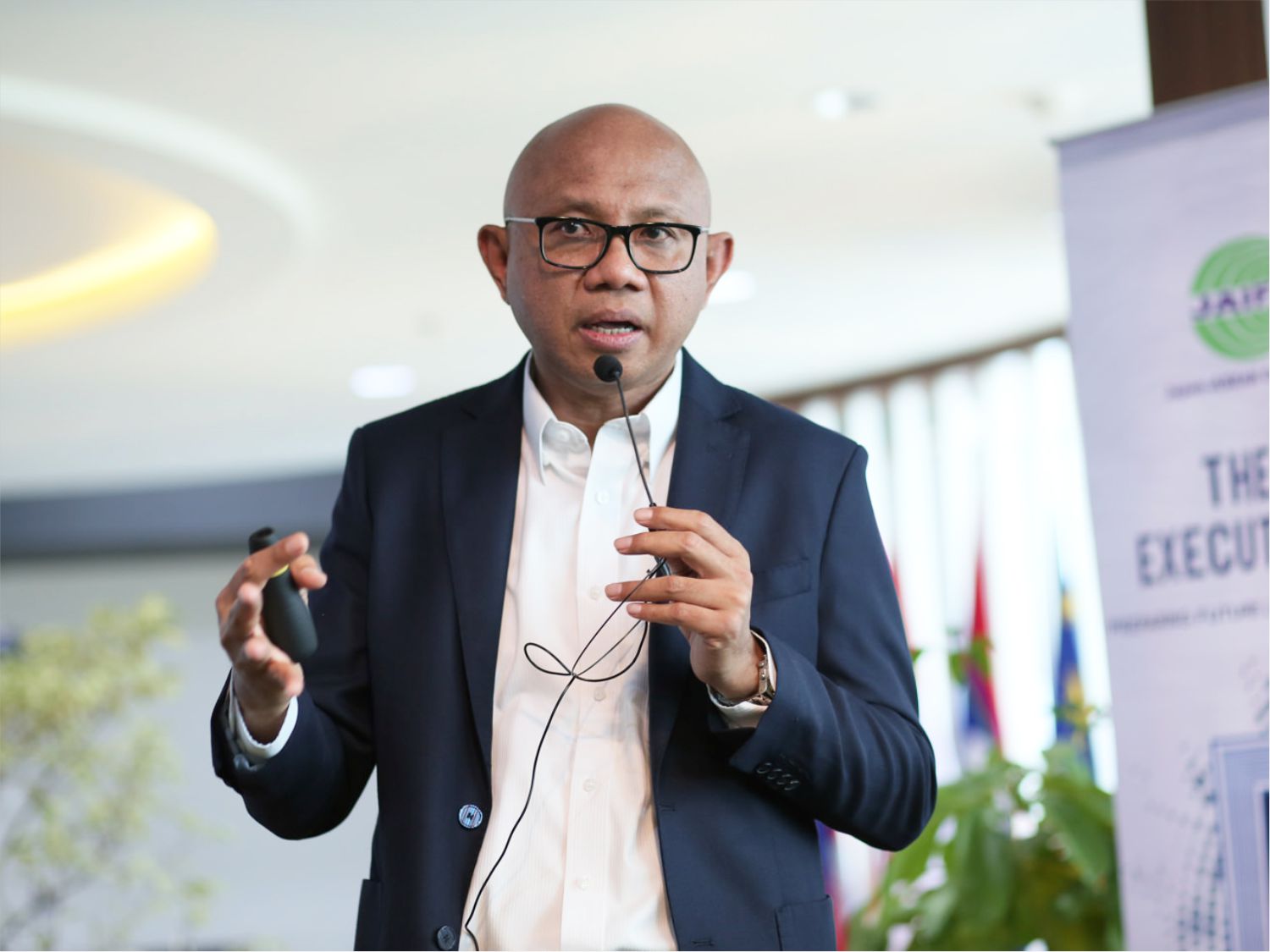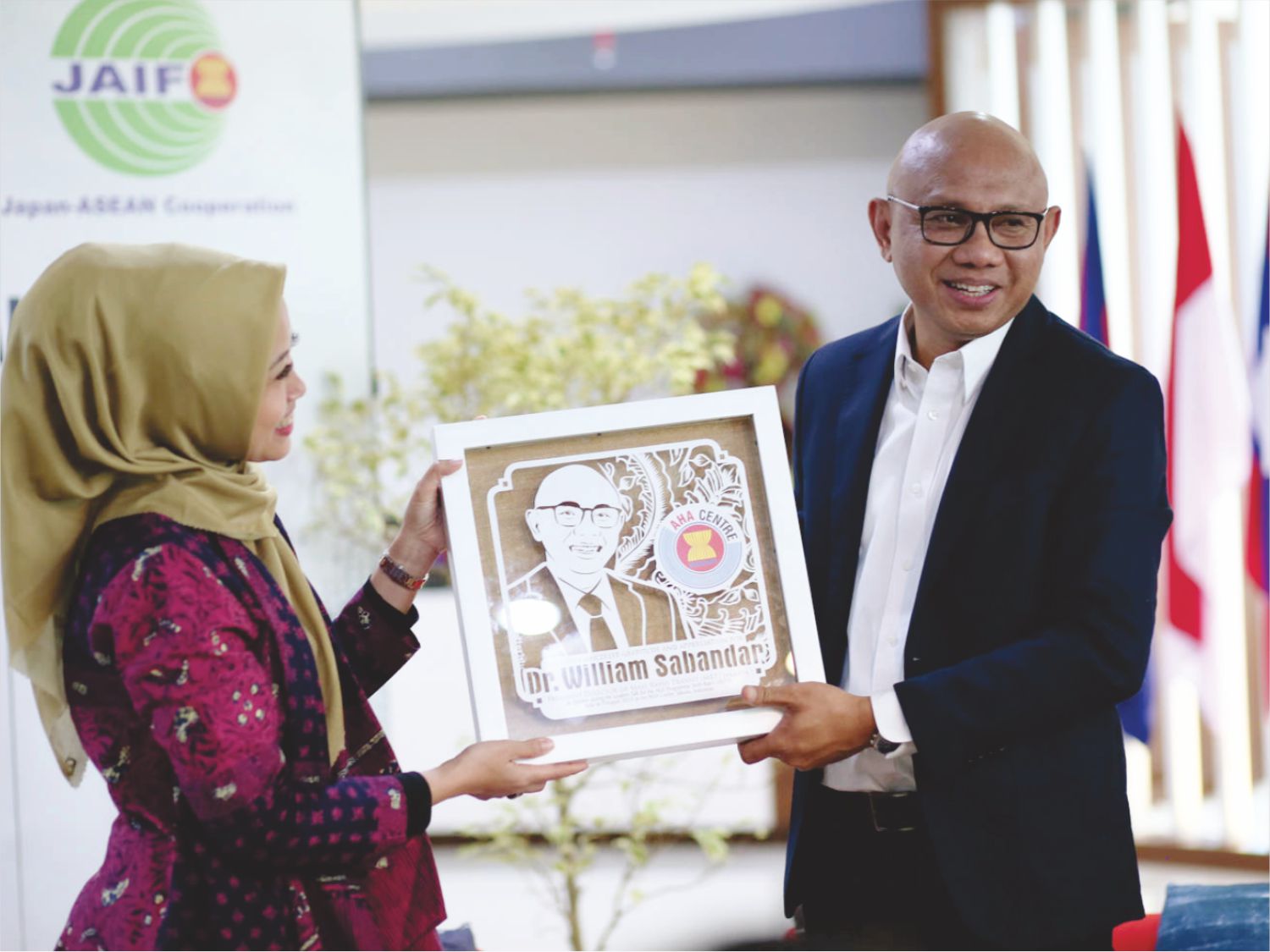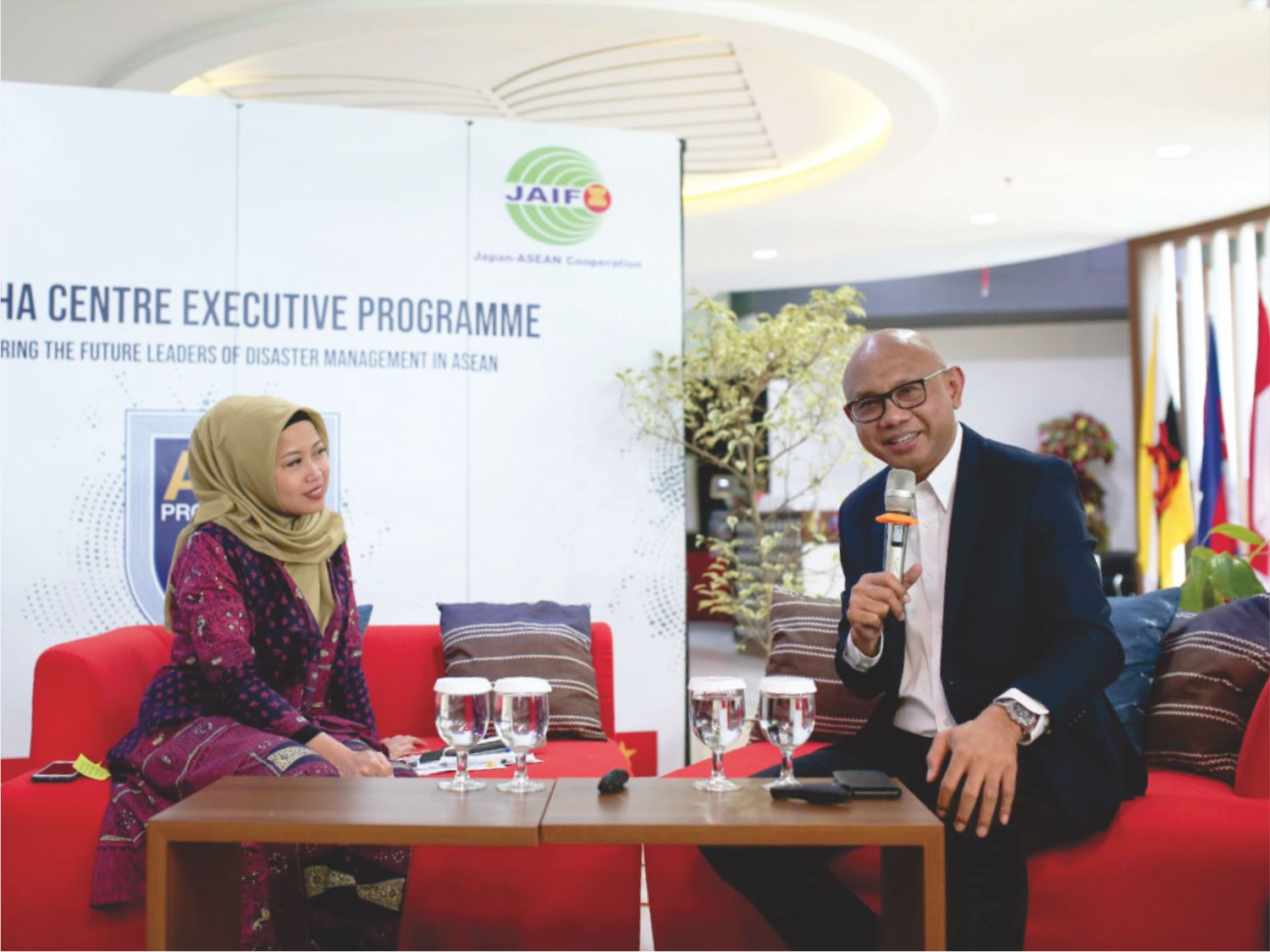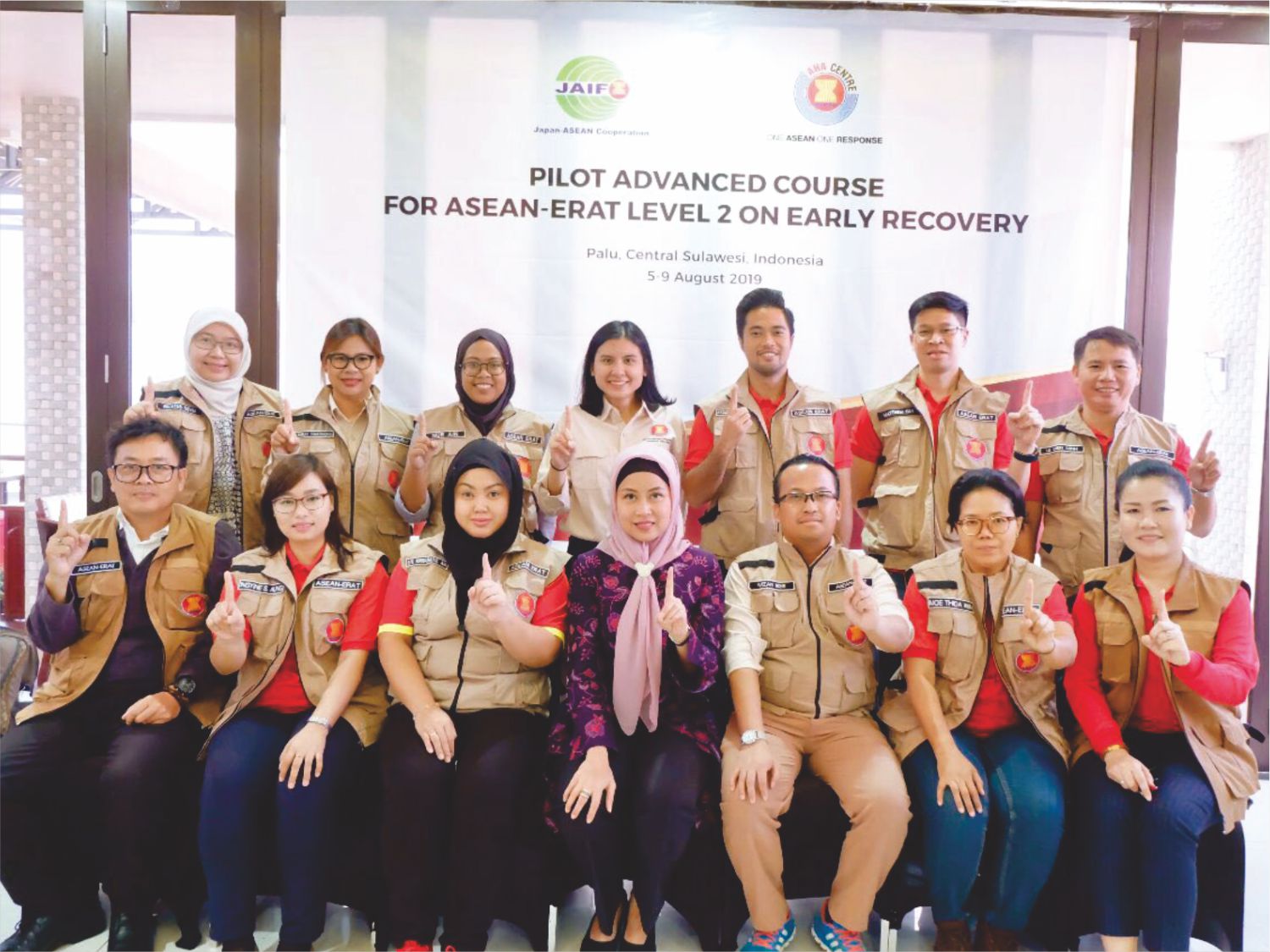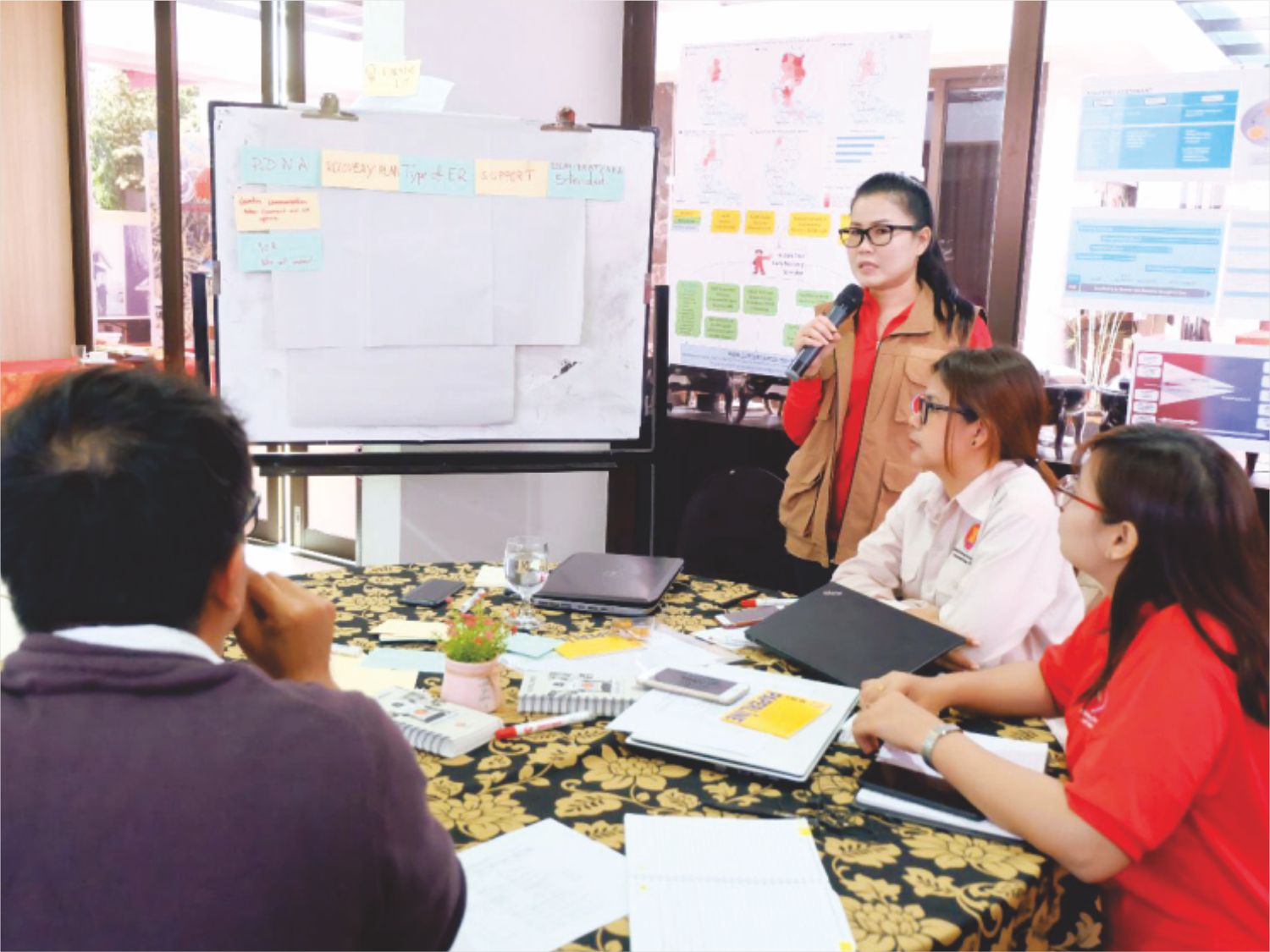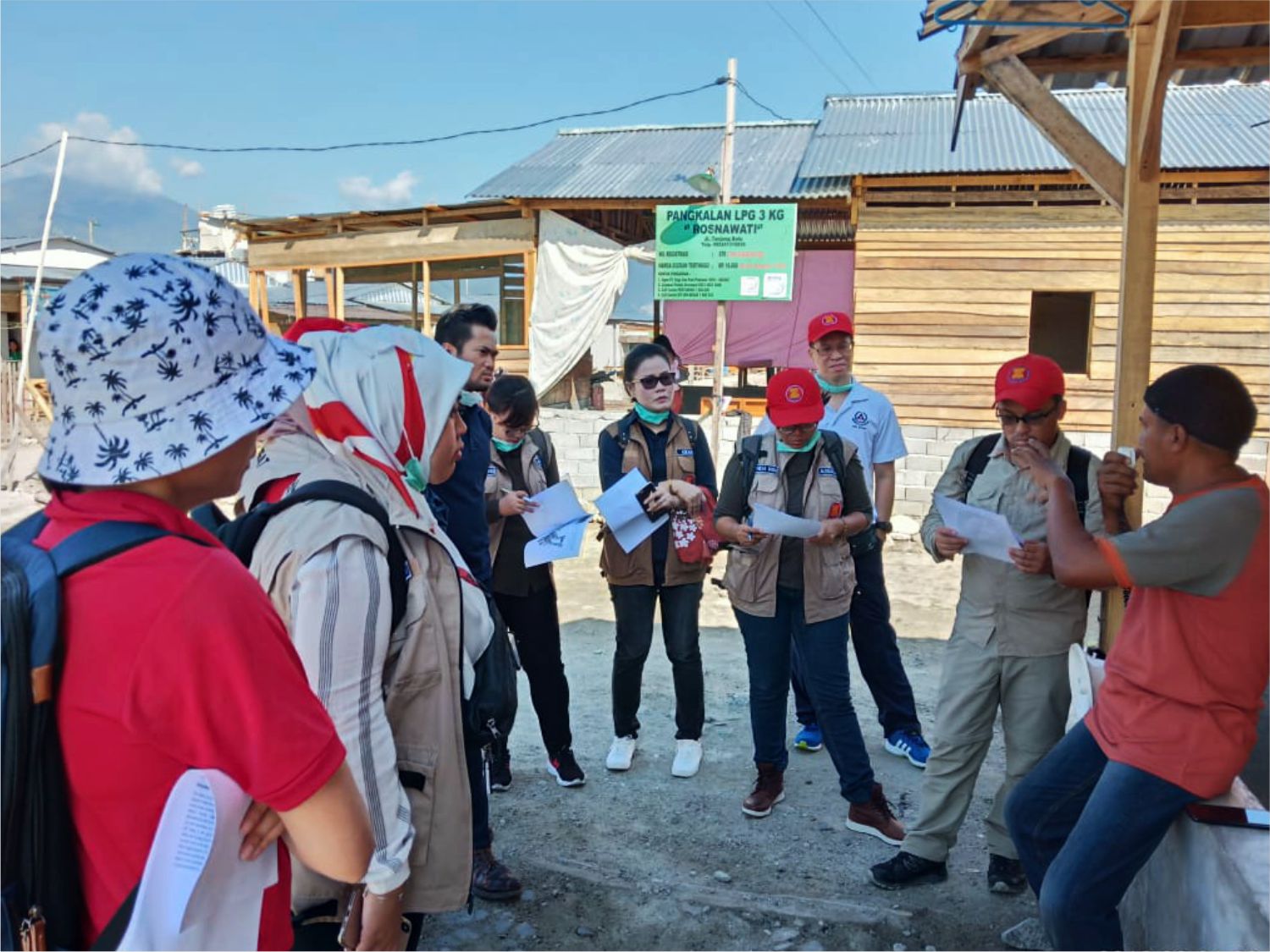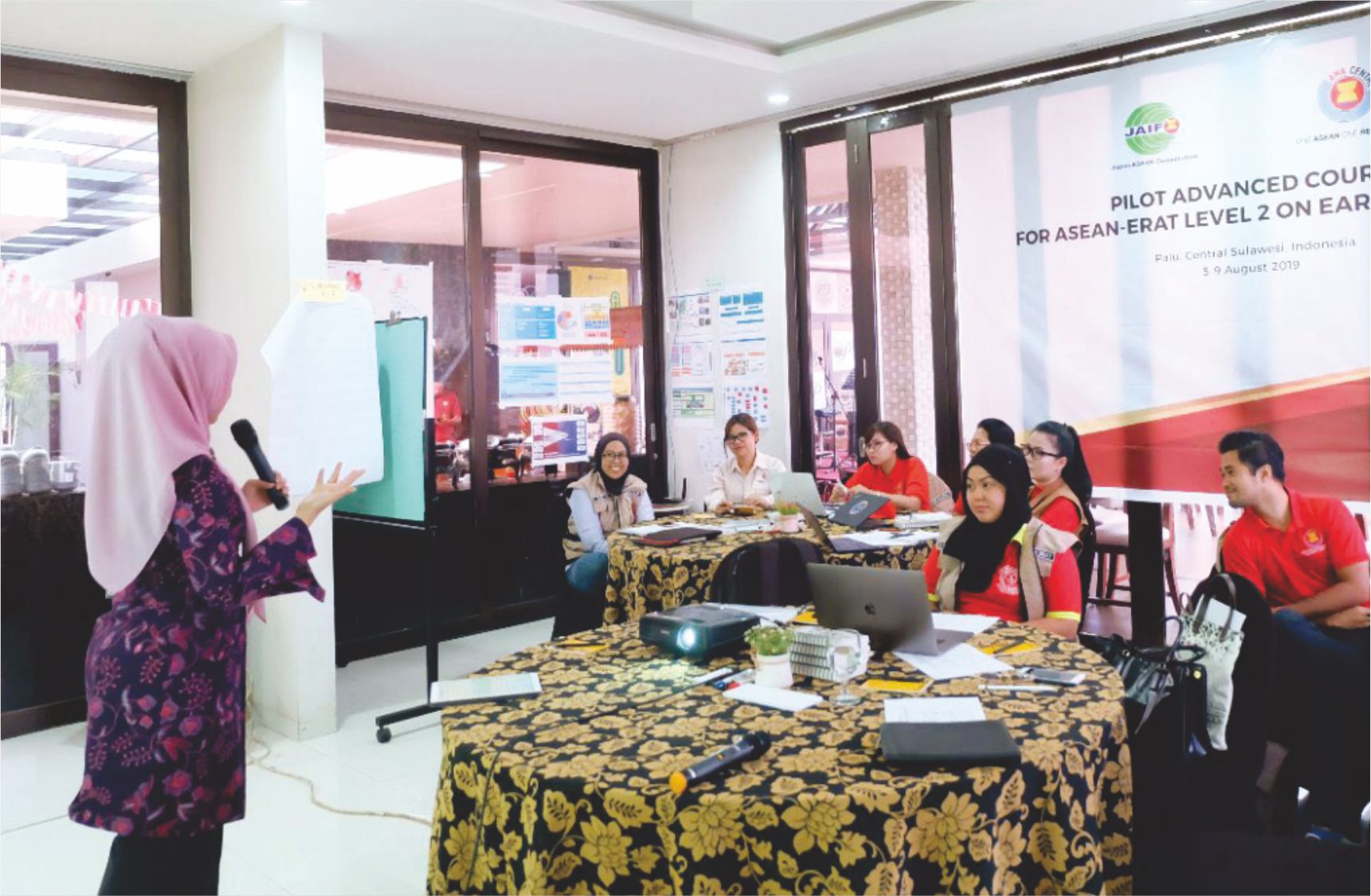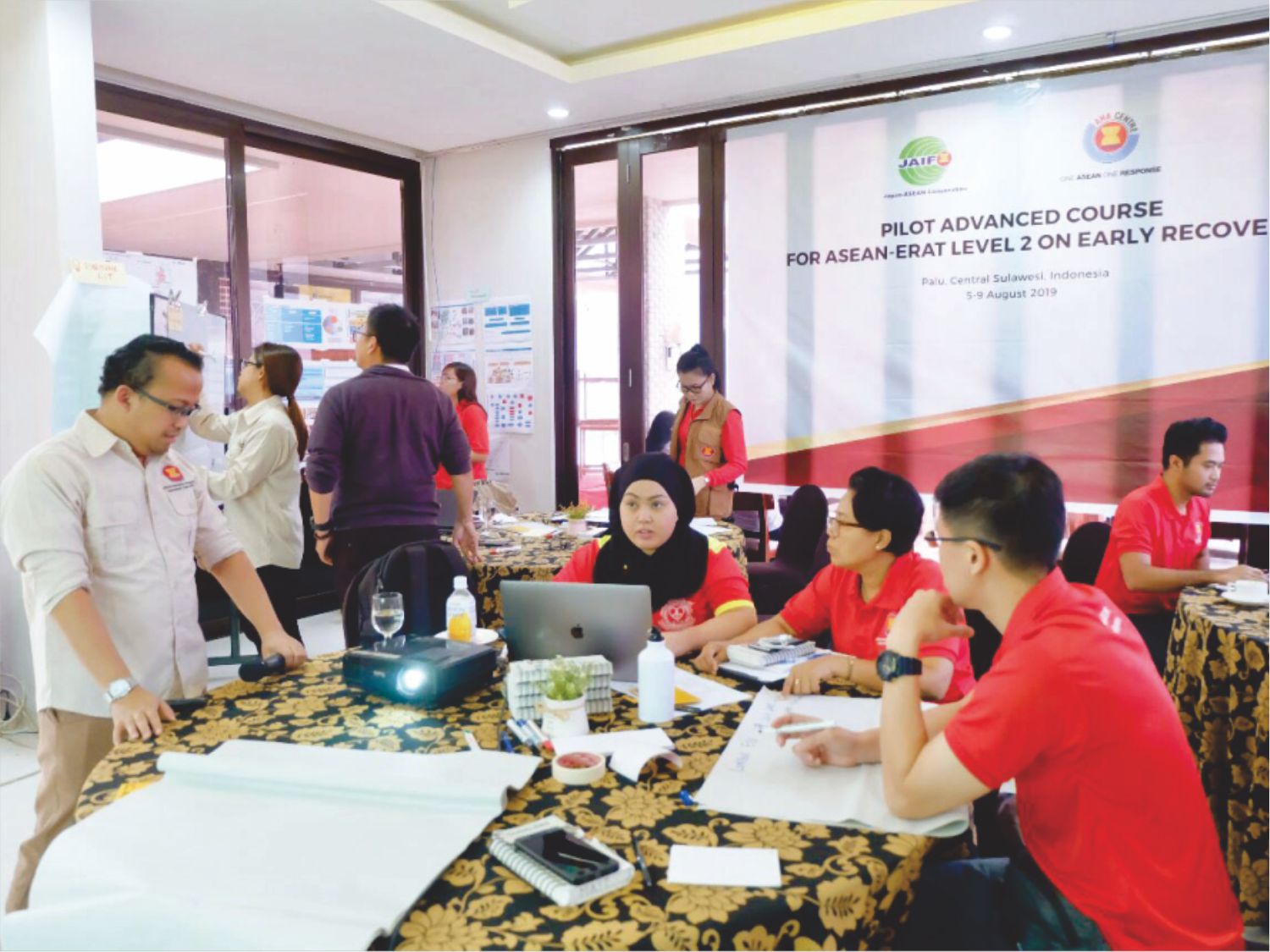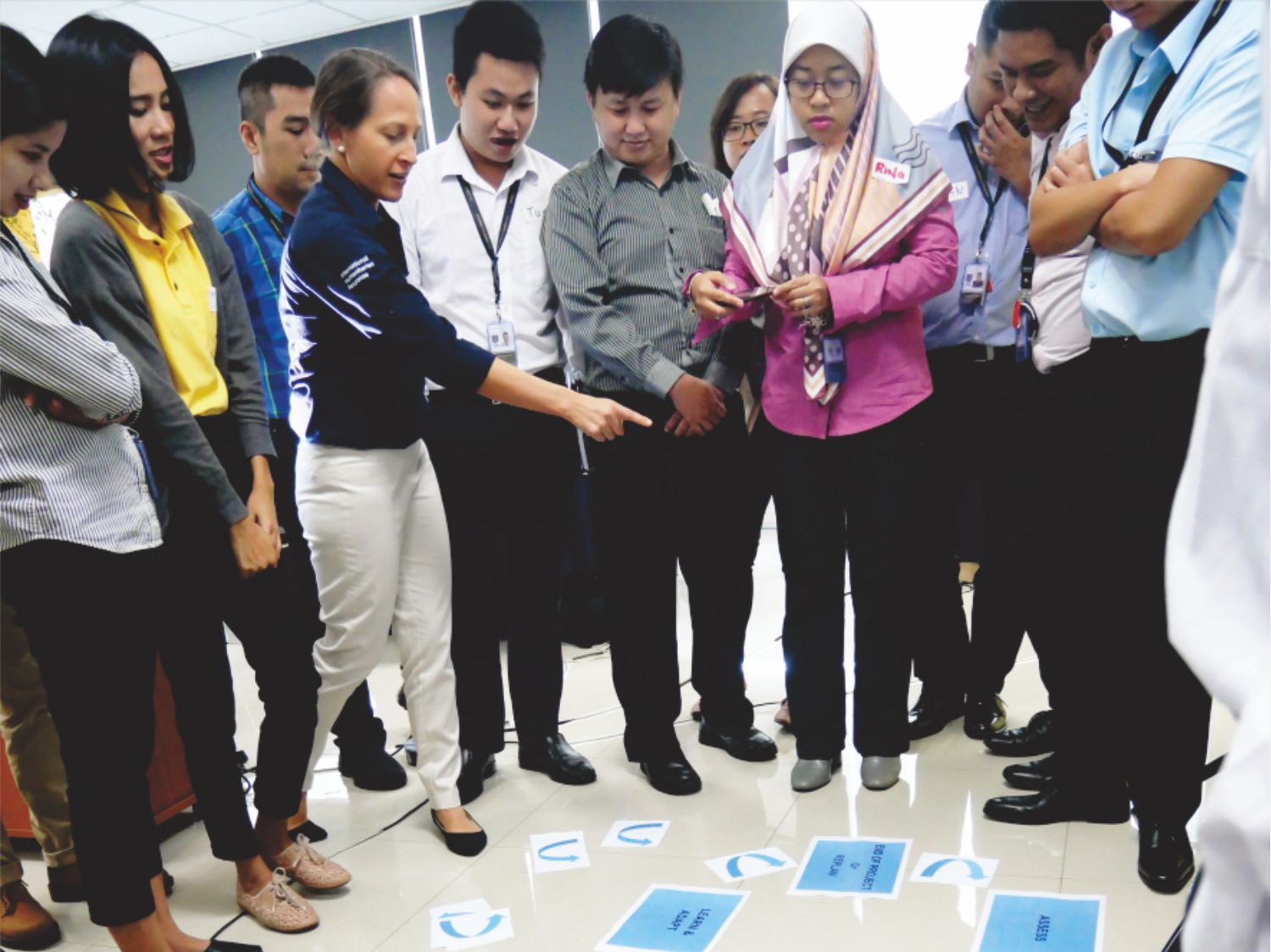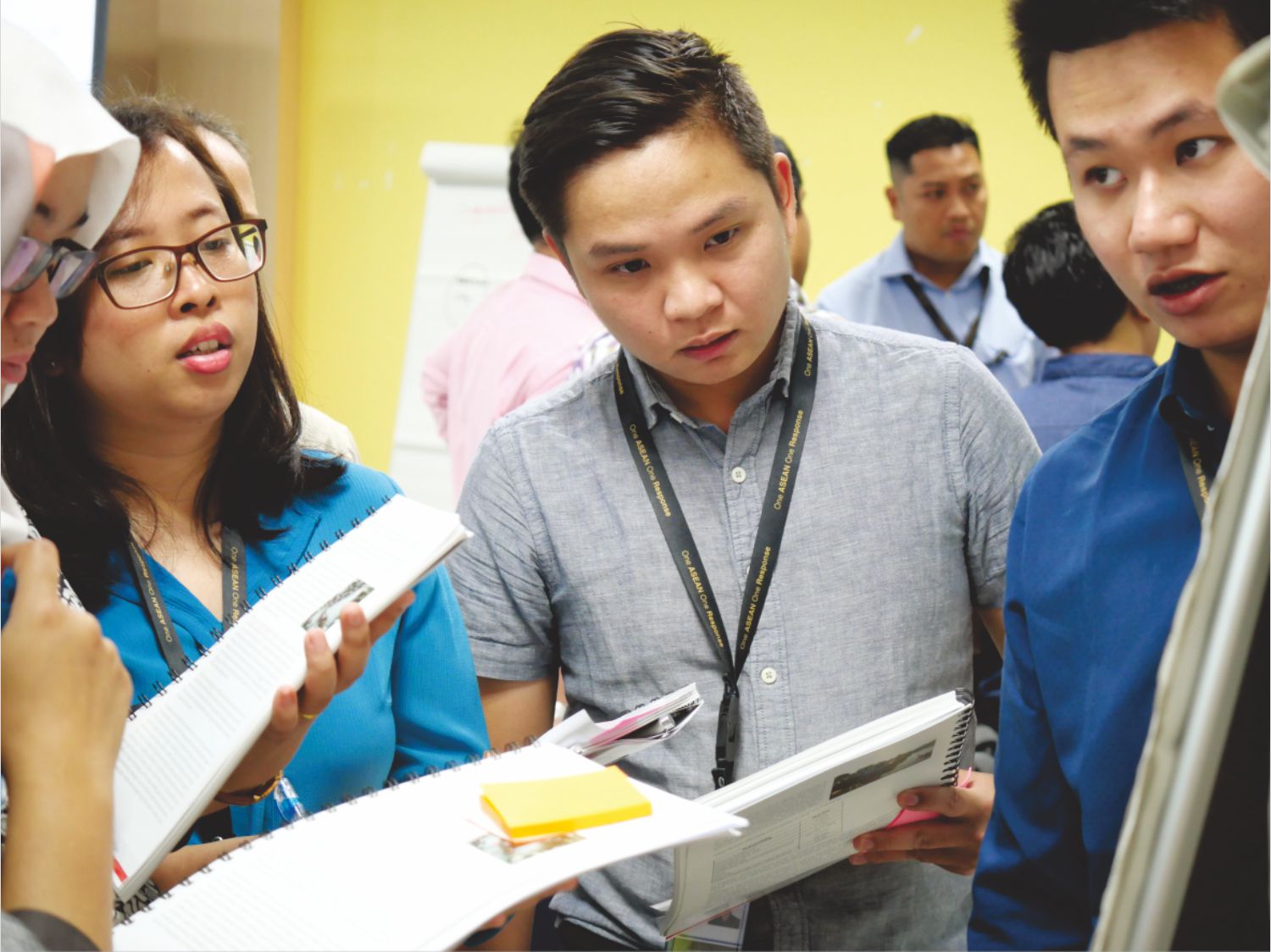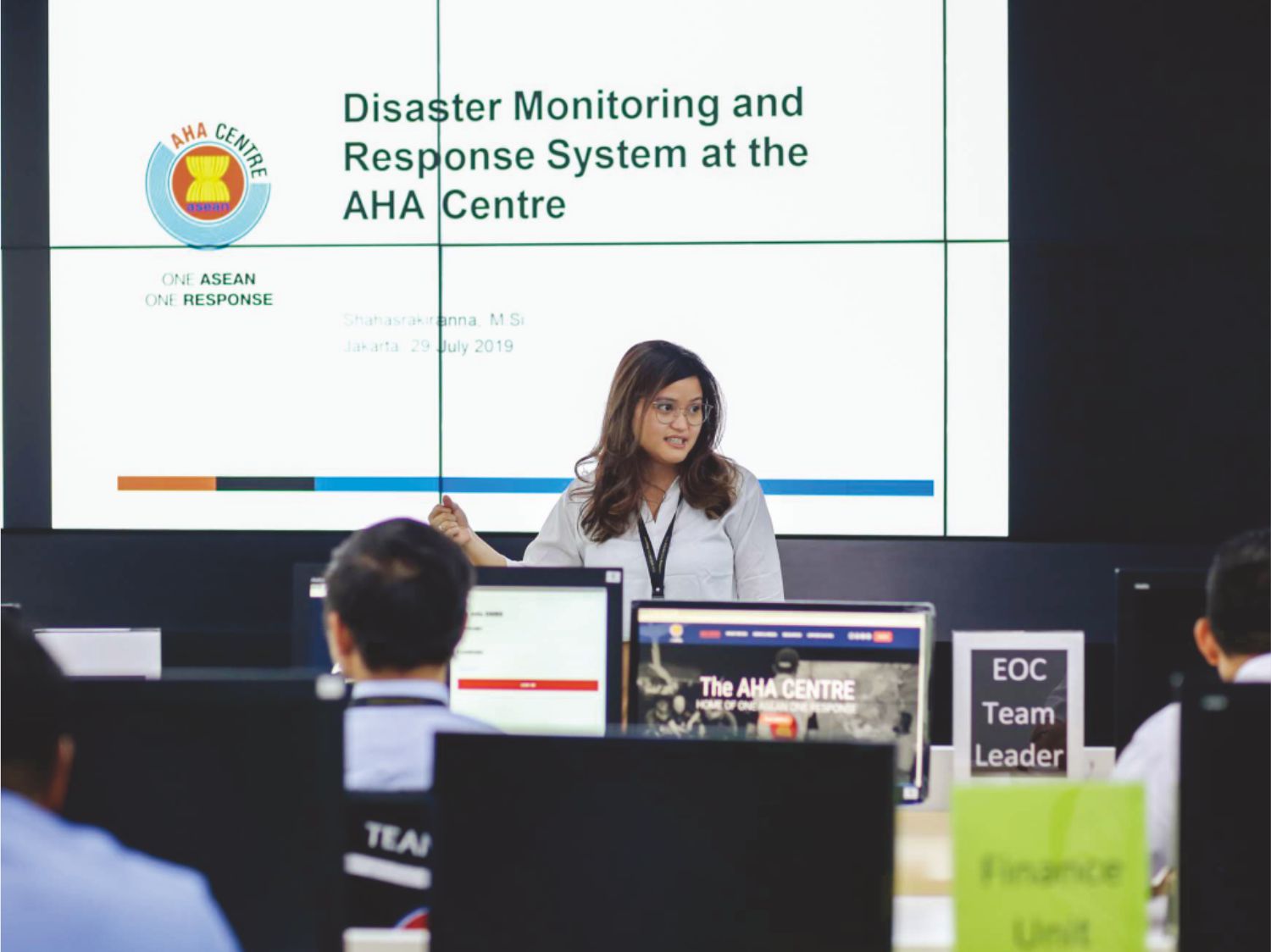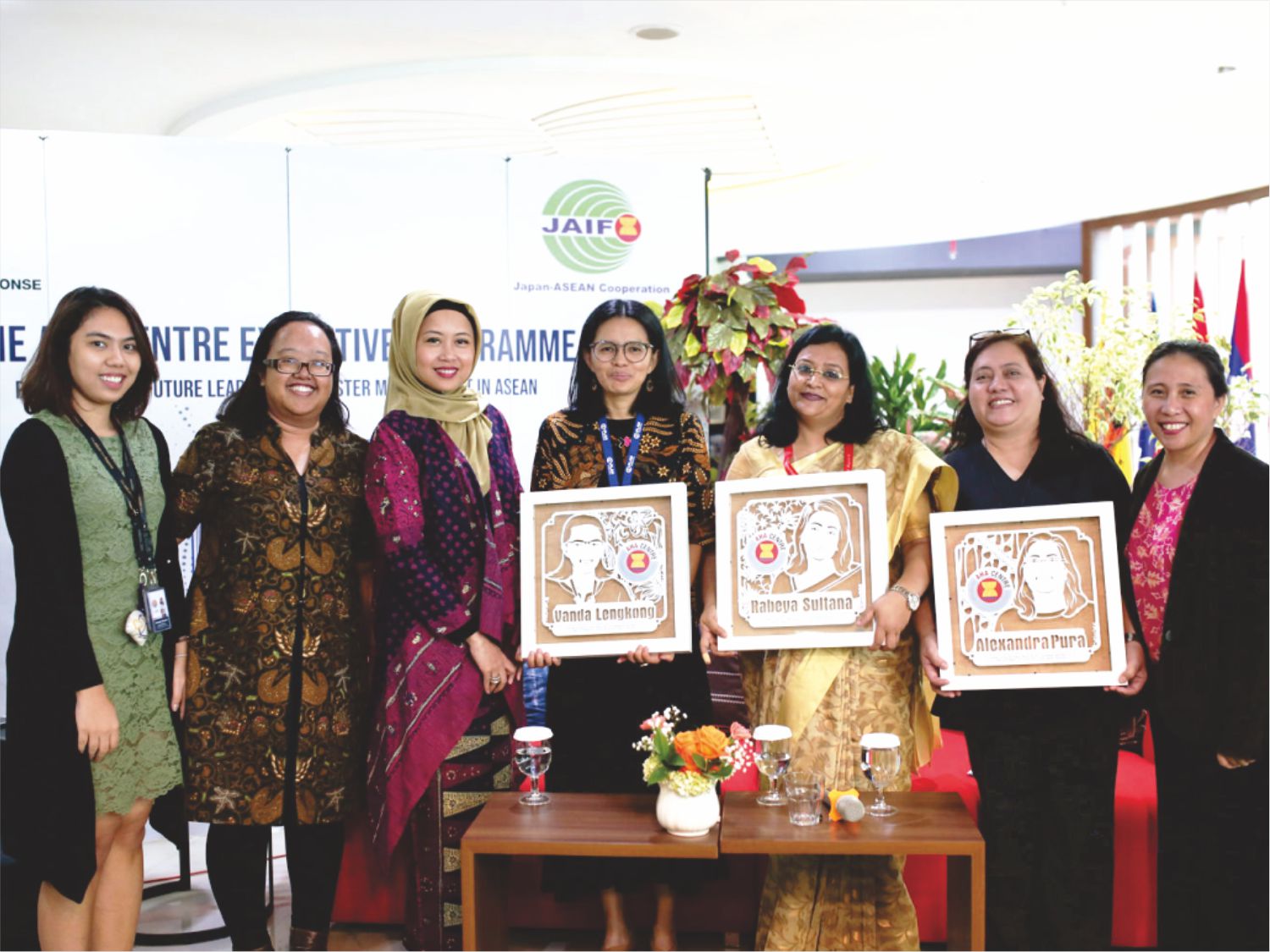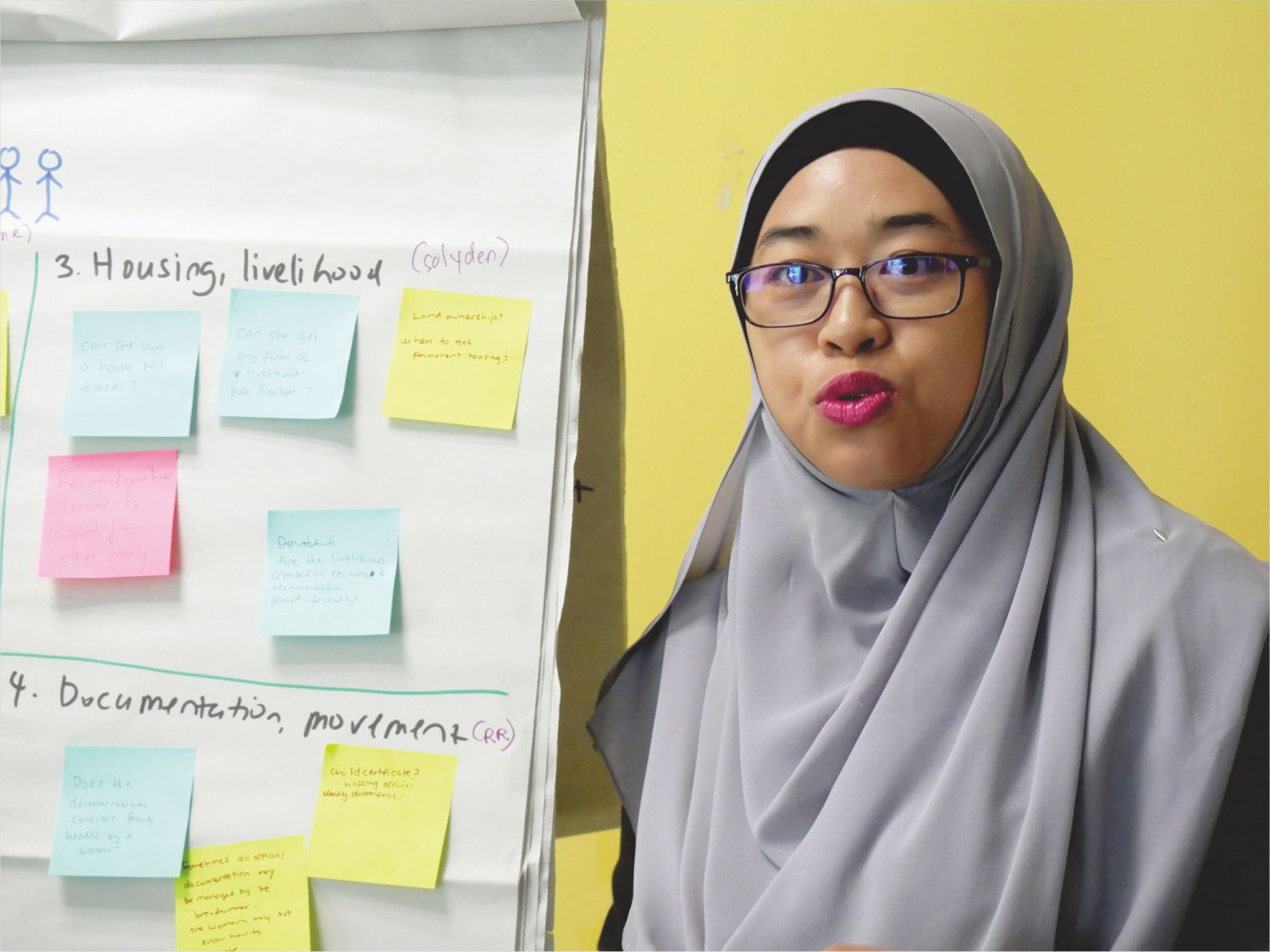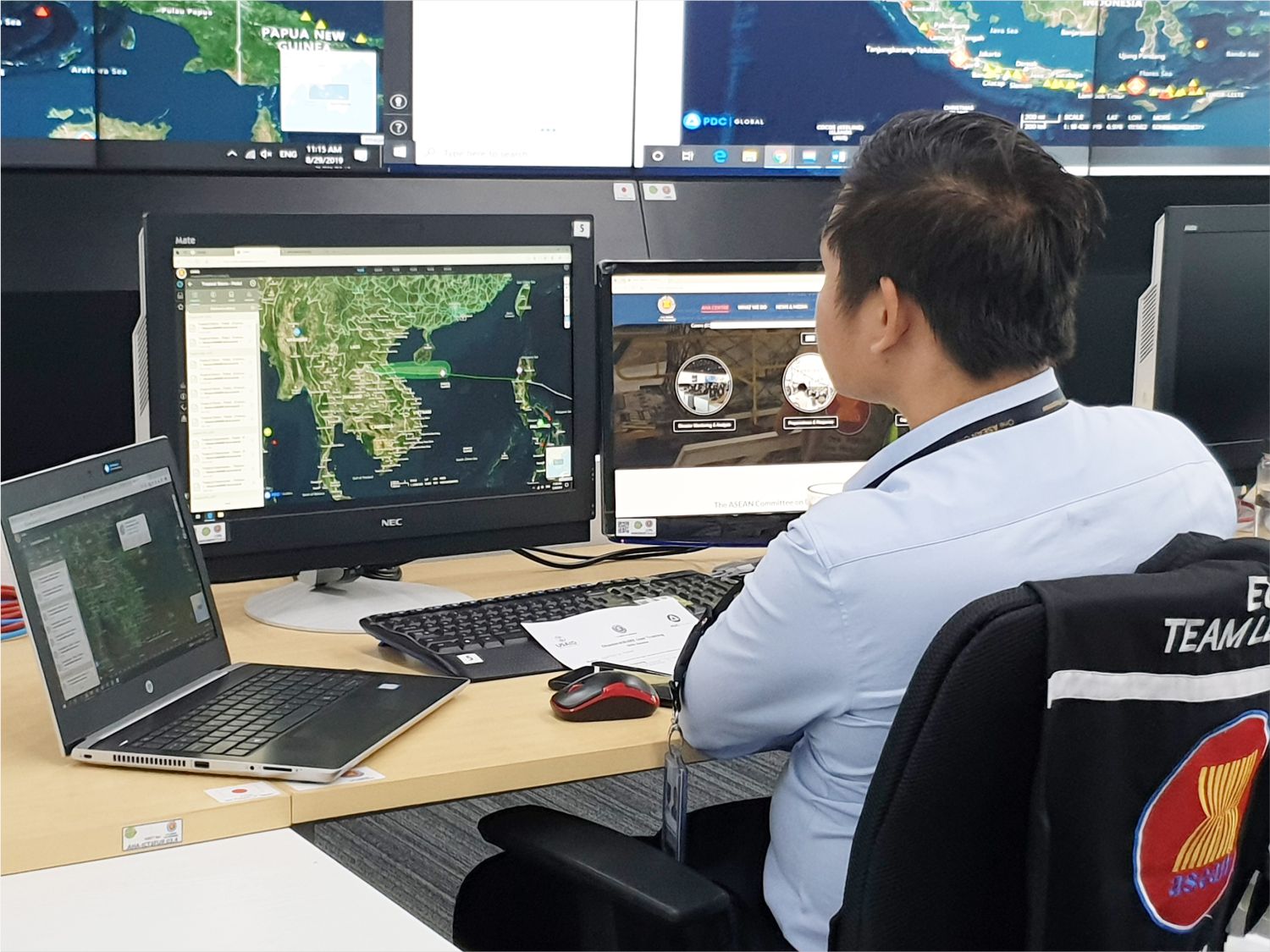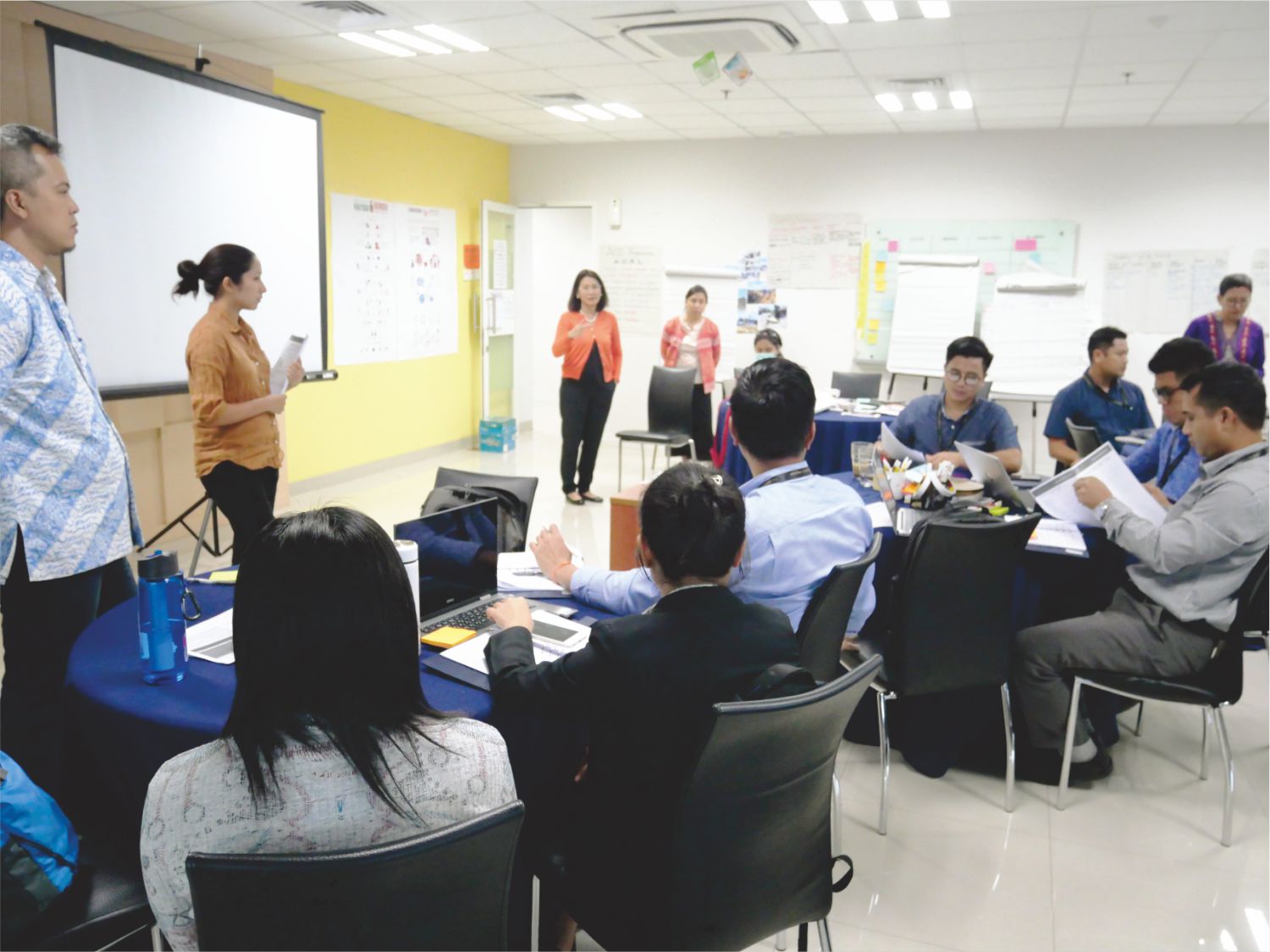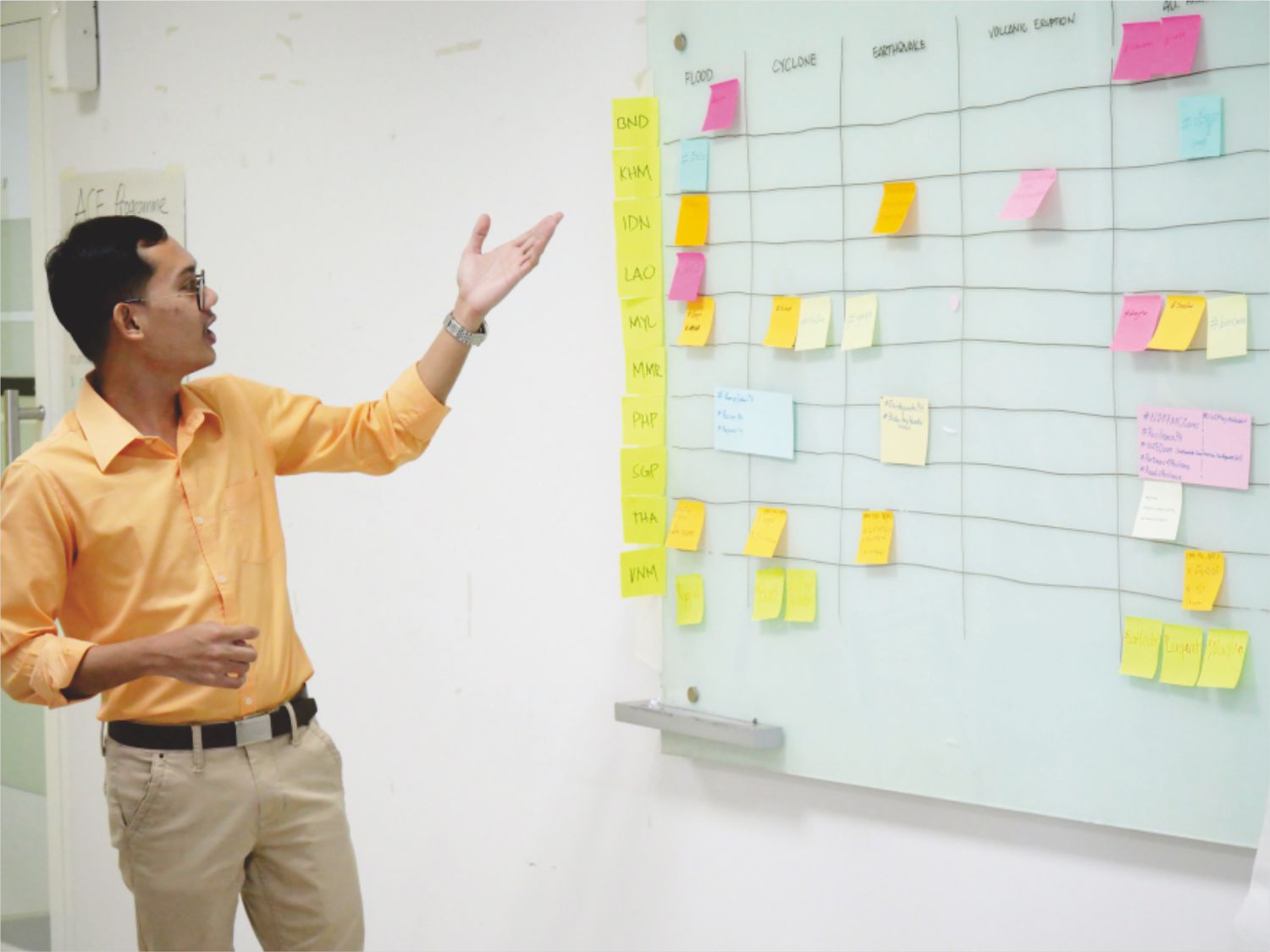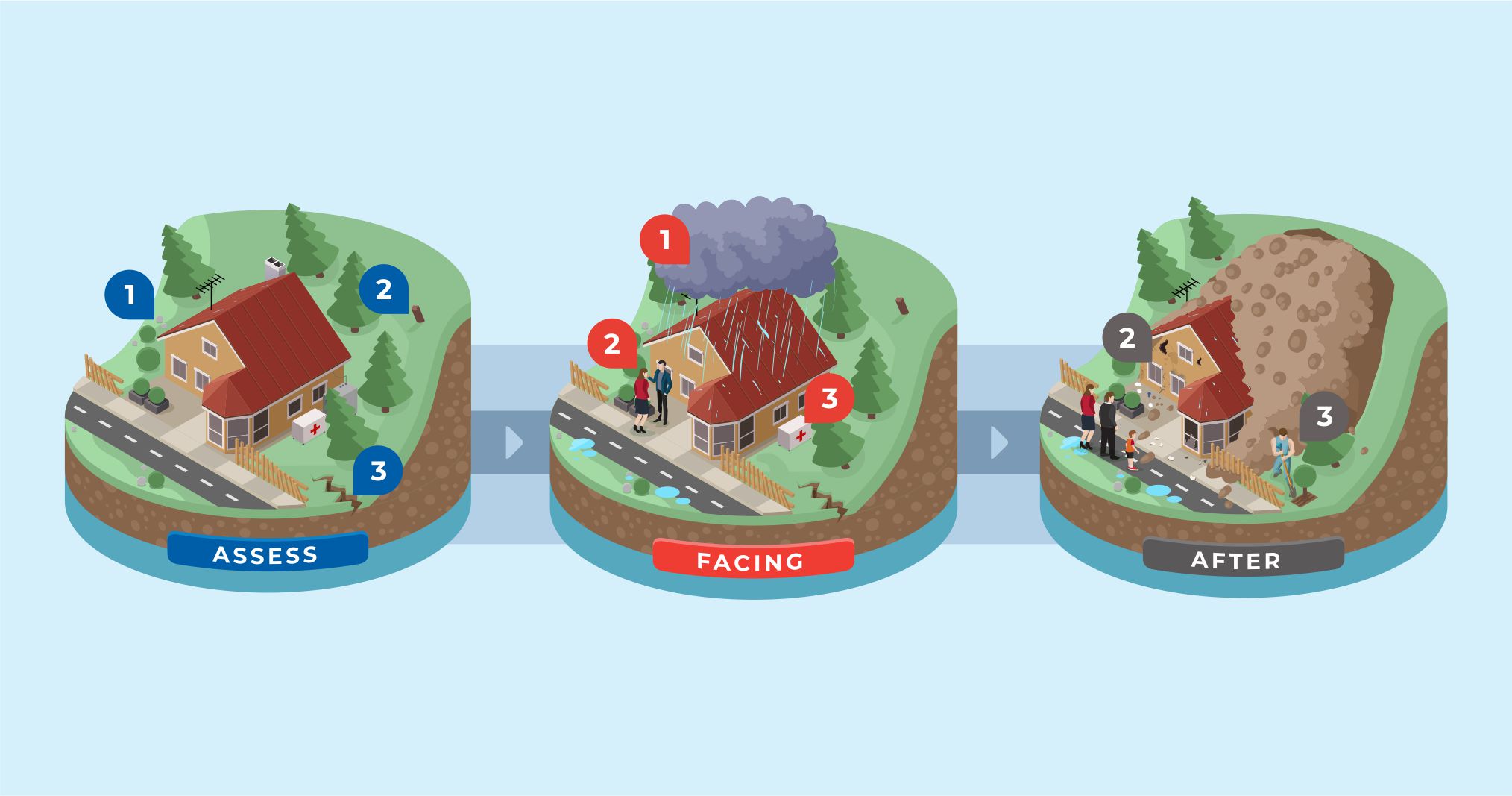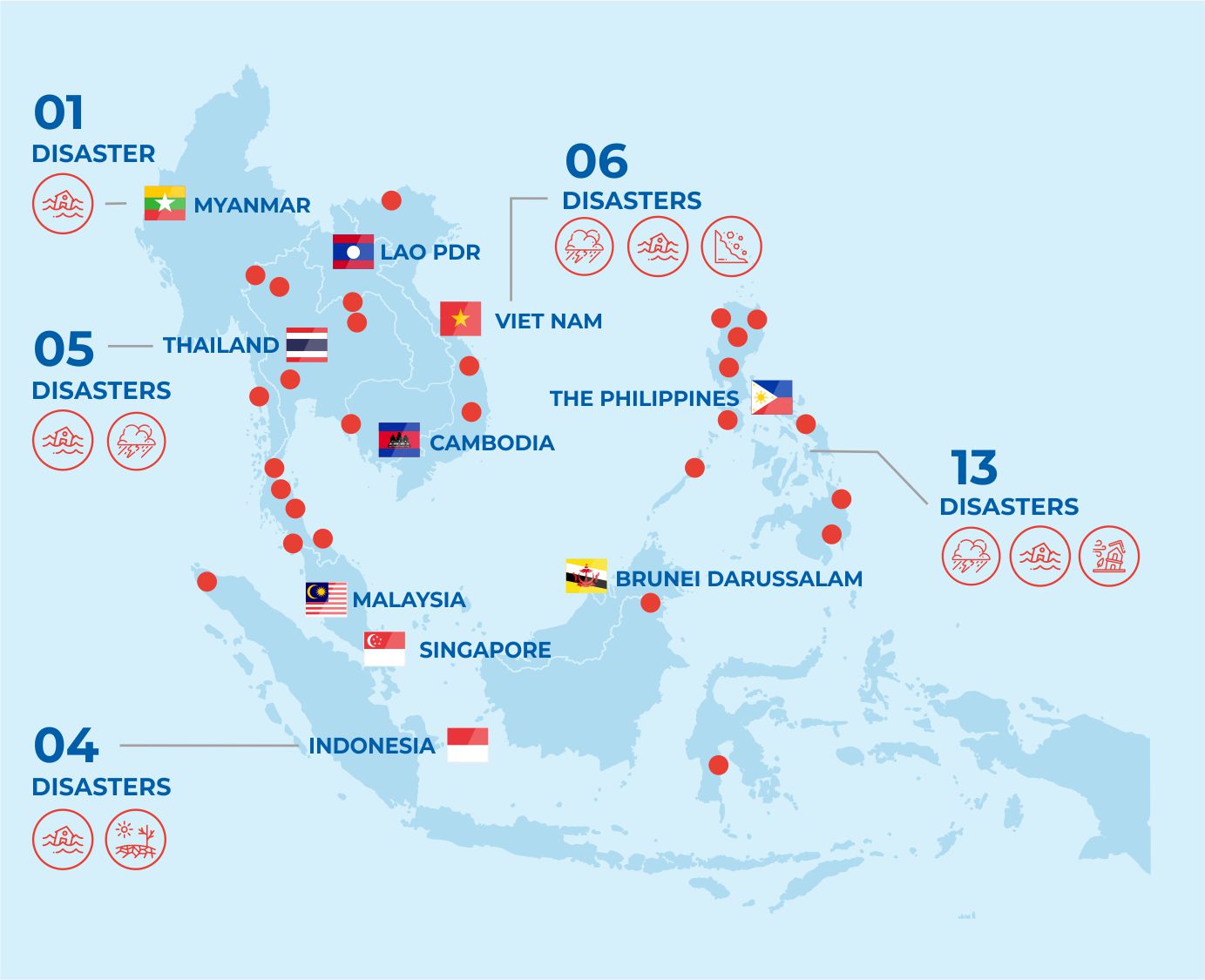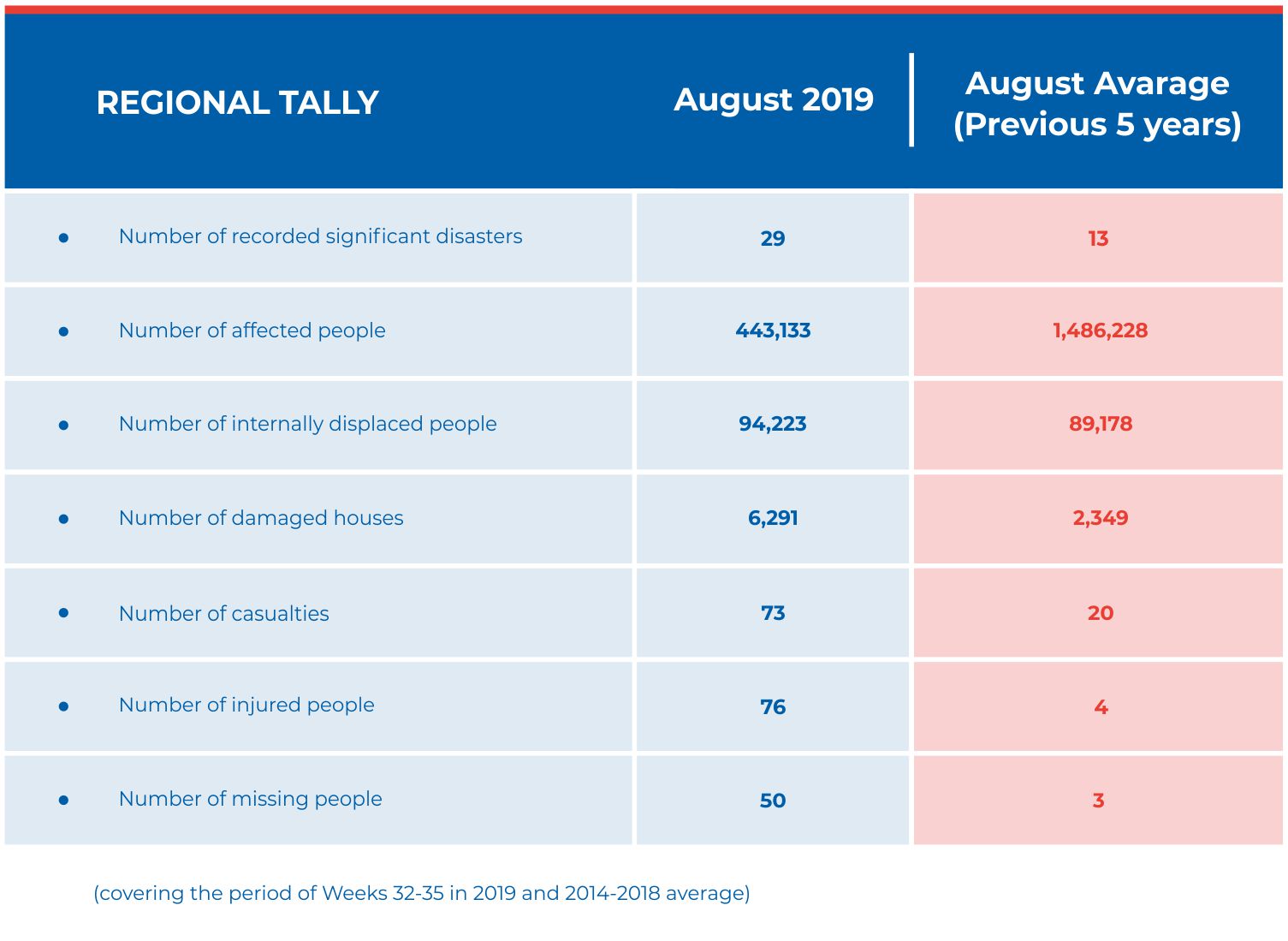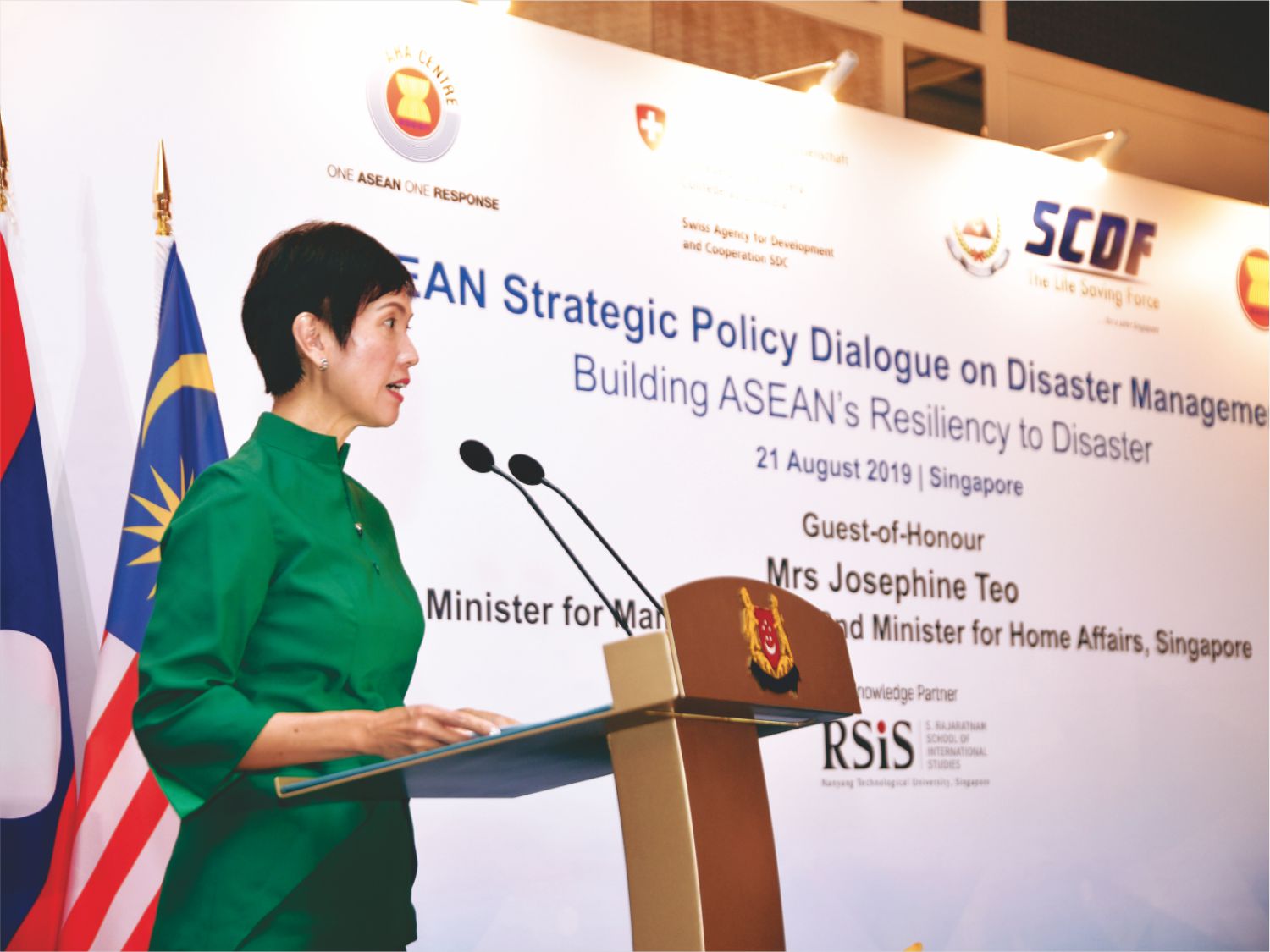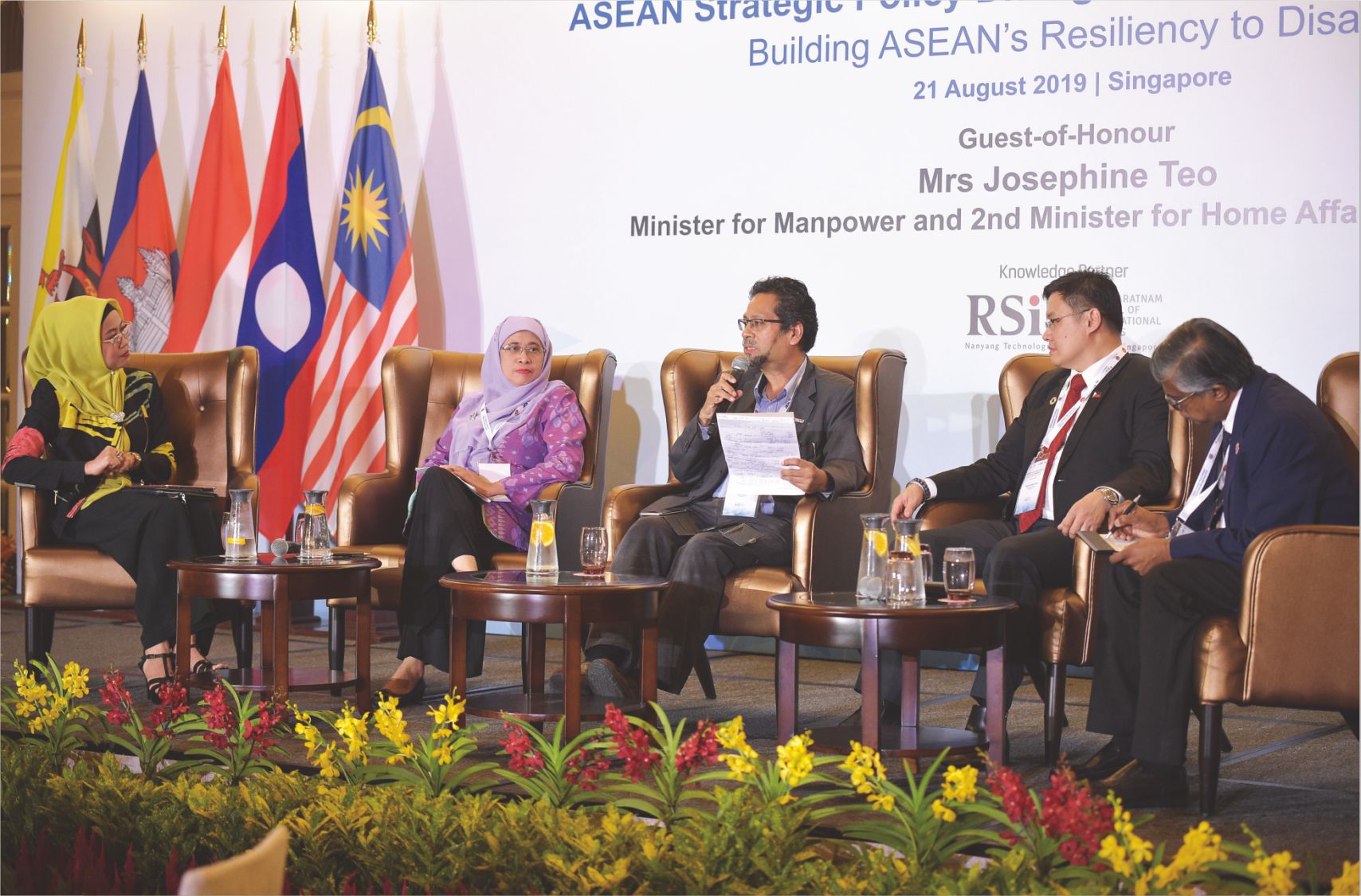Vol 54-DR WILLIAM SABANDAR

DR. WILLIAM SABANDAR
Continuing on from last month, this volume’s Other Side draws on the experience of an ASEAN’s leader in disaster management – Dr. William Sabandar – an experienced presenter in the AHA Centre Executive (ACE) Programme’s Leaders Talk series. Dr. Sabandar is the CEO of PT MRT Jakarta, the entity charged with the recent delivery and operation of Jakarta’s modern train network. However he is also renowned for his leadership throughout a range of ASEAN’s largest disaster events that have occurred over recent decades. The insights into Dr. Sabandar’s talk were provided this month by the ACE Programme’s own Sridewanto Pinuji.
Dr. Sabandar has been an ASEAN leader for decades, moving from business into the disaster response field, and most recently leading the establishment of the modern and effective MRT system in Jakarta. Dr. Sabandar drew on these array of leadership experiences as he spoke about the key qualities of leadership during an emergency event. Such experiences include the aftermath of the 2004 Indian Ocean tsunami, leading recovery after 2008’s Cyclone Nargis, and how these skills could be transferred leading the establishment of Jakarta’s MRT.
The key defining aspect of all such work, Dr. Sabandar reminds us that leaders must be on the ground. By doing so, they can talk to affected communities in order to understand and fulfil their needs, and supporting in any way possible from the front. “Leading in a crisis is to maintain certainty and belief, and also ensure no further casualties” he highlighted in the session. Another key lesson Dr. Sabandar has learned from managing various crises is how to develop a strong, supportive mentality for teamwork and togetherness for all members of a team. This is closely followed by building trust that a team will work together to eventually solve the problems and complete their job with quality and good timing.
Dr. Sabandar believes that strong leadership during a crisis can also attract more people to engage and provide support. This, he said, only can be achieved when the leader can maintain integrity and trust. Trust is key in a crisis, as if it diminishes, it can jeopardise the work and efforts that have previously been developed.
“THEREFORE, WHEN SUCCESS CAN BE ACHIEVED, LEADERS SHOULD MAINTAIN THE MOMENTUM AND BUILD ON THIS OUTCOME”
DR. WILLIAM SABANDAR
Dr. Sabandar also believes that not only do disasters engage current leaders, but they can also create new leaders, as everyday individuals are thrust into roles that highlight their internal leadership qualities. People who are on the ground during disaster can often find themselves in situations where they are required to take the lead, and skills such as communication, decision-making, focus and preparedness to change can all come to the fore.
Overall, while Dr. Sabandar has high hopes for the future of disaster management in the ASEAN region, he also highlights a number of key areas requiring more attention as ASEAN continues in its disaster management journey. Firstly, he recognises that preparedness and prevention require more attention through education, particularly for communities to understand disaster risk be empowered to undertake their own prevention and preparedness efforts. This requires attitude shift and extra resourcing, with focus moving away from the historic response-orientated context.
Secondly, Dr. Sabandar believes more attention needs to be afforded to clearer understanding of the nature of the disaster itself, which requires knowledge regarding the science and complexity of a phenomena, to help determine proper action to take. Lastly, when looking at the role of bodies such as ASEAN and the AHA Centre, Dr. Sabandar recognises the important role played by ASEAN in bridging governments and various humanitarian institutions. This role, he said, can significantly enhance the preparation, response and recovery efforts during the aftermath of a disaster. Central to this is the AHA Centre itself, which forms a new and innovative model for managing disaster in the region – a mechanism that can be followed by other regional bodies around the globe.
Written by : Sridewanto Pinuji | Photo : AHA Centre
- Published in The Other Side
Vol 54 – ASEAN-ERAT LEVEL 2 PILOT ADVANCED COURSE ON EARLY RECOVERY

ASEAN-ERAT LEVEL 2 PILOT ADVANCED COURSE
ON EARLY RECOVERY
Another key course development to increase the reach and impact of the ASEAN Emergency Response and Assessment Team (ASEAN-ERAT) programme is the Level 2 Pilot Advanced Course on Early Recovery, which was implemented for the first time in Palu, Central Sulawesi, Indonesia from 5 to 9 August, 2019. Developed to reduce the gap between emergency response and the long-term recovery phases, the course aims to provide support to affected ASEAN Member States by analysing results of rapid assessments, and providing guidance and recommendations to a recovery plan during early stages of disaster recovery.
Implementing the course in Palu – the centre of one of 2018’s major disasters – ensured participants were exposed directly to the concept of Early Recovery within a real ASEAN context. By the end of the course 10 ASEAN-ERAT members from Brunei Darussalam, Cambodia, Lao PDR, Malaysia, Myanmar, Singapore, Thailand, Viet Nam, the Myanmar Red Cross Society, and the ASEAN Secretariat, were all added to the pool of ASEAN-ERAT Level 2 specialists, ready to support affected Member States with their new distinct expertise.
During the course, classroom sessions were delivered by the UN-ESCAP and UNDP on Post Disaster Needs Assessment (PDNA) Methodology and Early Recovery Cluster in ASEAN, as well as by the World Bank on Global Rapid Post-Disaster Damage Estimation (GRADE). Such insights and contributions to the course significantly enhanced the quality and the delivery of the content and discussions. Participants were also provided hands-on learning opportunities as they visited several recovery efforts that have been taking place since the region’s triple-disaster events, including a visit to the community at Mamboru village to see the livelihood recovery efforts in a coastal area. Subsequently, the participants were also invited to witness the ground-breaking ceremony of ASEAN Village at Tondo, which stands as a programming outcome of the early recovery plan managed by the AHA Centre and supported by Brunei Darussalam and the Philippines in the year since the disaster.
To round-out the course, the final day saw the injection of a simulation exercise to enable participants to apply their knowledge gained throughout the previous days, with participants challenged to produce analysis and recommendation for another recovery programme and deliver them to the group. Overall, the implementation of Pilot Level 2 courses such as this continue to be a success for the ASEAN-ERAT programme, with the benefits of increased specialisation and skill development set to continue the ASEAN region’s efforts to become stronger, speedier and united in responding to disaster wherever and whenever it may strike.
Written by : Grace Endina & Sovi | Photo : AHA Centre
- Published in AHA Centre Diary 2
Vol 54-ACE PROGRAMME DIARY AUGUST

ACE PROGRAMME DIARY AUGUST
The second month of the AHA Centre Executive (ACE) Programme saw the ASEAN regions sixth batch of future disaster leaders take part in a range of training, discussions and practical activities. The following diary entries were developed by the team to reflect on their journey in August.
WEEK-1
The ACE Programme participants began their second month with an intensive 7-day course on project management and proposal writing, delivered by Peter Grzic and Petra Letter from RedR Australia. As part of the course, participants learnt about effective planning and implementation of projects, and gathered new knowledge on developing convincing project proposals, through an array of lessons, interactive activities, discussions, and group presentations. Peter and Petra walked the participants through the cycle of project management, and introduced useful tools such as stakeholder analysis, problem and objective trees, and the logical framework, amongst others
WEEK-2
To close out their course on project management, participants undertook one-on-one sessions with facilitators from RedR in order to determine individual projects that will be developed throughout the coming months, and submitted to AHA Centre Senior Management at the end of the programme. The AHA Centre’s LA Dimailig from the Disaster Monitoring and Analysis team then introduced participants to the Centre’s WebEOC platform, inviting participants to engage with the software through a number of games and replications. After a day off to celebrate ASEAN Day, the week came to an end with another round of interesting Leaders Talks, with insights on disaster and leadership provided by Vanda Lengkong (Head of Disaster Risk Management for Plan International Asia Region), Rabeya Sultana (Country Director of HelpAge International Bangladesh), Alexandra Jing Pura (Country Director of Christian Aid Philippines), and Dr William Sabandar (CEO PT MRT Jakarta).
WEEK-3
Week 3 of August saw ACE participants attended a 3-day course on Rapid Assessment, conducted by the ASEAN-ERAT team and an ACE Programme Alumni from Batch 3, Mark July Yap. The course provided assessment skills and knowledge for participants to assess disaster-affected areas, and the needs of disaster victims – particularly in ASEAN countries. The theme of rapid assessment then continued, with a specific training on Rapid Assessment for Women and Children delivered by the UNFPA, UN Women and UNICEF. This course introduced participants to the specific vulnerabilities, capacities, and needs of women and children in disasters, facilitate their understanding of ethical considerations and core principles relevant to data collection on women and children in emergencies, and equip them with practical tools for data collection and analysis.
WEEK-4
This week the ACE participants attended a 3-days course on the International Humanitarian System delivered by three representatives from the regional office of UNOCHA. The facilitators delivered briefings and activities providing participants an opportunity to further understand the interoperability of the UN cluster system in relation to the ASEAN system.
The week continued with a pre-course on Critical Incident Leadership, delivered by two facilitators from New Zealand; Mr. Chris Webb and Mrs. Michele Daly. Participants were introduced to the theories of disaster risk management framework, hazards, and the five dimensions of meta-leadership. The week closed on Friday 23 August 2019 with all participants attending a dinner reception to celebrate the opening of the Critical Incident Leadership Course, which was hosted by the New Zealand Ambassador to ASEAN, H.E. Pam Dunn.
WEEK-5
During the first half of the week, ACE Programme participants received training on Post Disaster Needs Assessment (PDNA) from United Nations Development Programme (UNDP) expert Ms. Jeannette Fernandez Castro. Ms. Castro shared her knowledge and skills on disaster and loss analysis to participants, who learnt about differentiating between damage and loss, and the tools that can be used to provide stakeholders, donors and decision makers with quantifiable estimation of the cost of recovery. To put the knowledge into practice, participants were divided into groups working on different sectors, and developed a PDNA and recovery plan for a fictitious country “Someland”. For the second half of the week, the AHA Centre’s DMA team, supported by Victoria Leat and Anom Parikesit from the Pacific Disaster Center (PDC), conducted hands-on training on the ASEAN Disaster Monitoring and Response System (DMRS).
“The DMRS is a very good tool for NDMOs to use to monitor disasters and plan for a response. The hands-on exercise was particularly very useful, and gave us an opportunity to really use the system” – Safrizan, ACE Programme participant from Malaysia.
Written by : Rina Nur Hafizah, Sridewanto Pinuji, Amelia Justina Lim, Ram Chum Mang, Putri Mumpuni | Photo : AHA Centre
- Published in AHA Centre Diary 1
Vol 54 – UNDERSTANDING VULNERABILITIES AND RISKS FACED BY WOMEN AND CHILDREN IN DISASTERS

UNDERSTANDING VULNERABILITIES AND RISKS FACED BY WOMEN AND CHILDREN IN DISASTERS
With the AHA Centre Executive (ACE) Programme taking place during the second half of 2019, we will bring to you insights of AHA Centre partners at work – showcasing their input and value through their engagement in the ACE Programme. Each article will be presented by a guest writer, who is also a participant in the ongoing programme, and one of the region’s future leaders on Disaster Management.
Gender inequity – alongside the context for children and people with disabilities (PWD) see very high rates of vulnerability for these groups in the face of disaster. While there are a range of social, political and economic complexities behind this context, the reality is that women, children and PWD are much more heavily affected by disasters in ASEAN. While vulnerability is high, the context for women also holds great significance and opportunity for their engagement in mitigating and managing disaster in the region. As part of the ACE Programme, participants were engaged in interesting and eye-opening training on Rapid Assessment of Vulnerabilities and Risks faced by Women and Children in Humanitarian Settings.
The training course ran in August 2019, and was conducted by UNWOMEN, with support from the United Nations Population Fund (UNFPA) and United Nations Children Fund (UNICEF). The Rapid Assessment for Women and Children course aims to increase participants understandings of the specific vulnerabilities, capacities, and needs of women and children in disasters, facilitate their understanding of ethical considerations and core principles relevant to data collection on women and children in emergencies, and equip them with practical tools for data collection and analysis. Facilitators from the three agencies worked with participants to integrate gender and disability component into disaster management and emergency response programme design.
During the course, facilitators increased ACE participants’ understanding on the basics of gender, disability and child protection; vulnerabilities and risk factors that women and girls/boys face in emergencies; how to gather and collect data in emergency settings that includes gender-based violence cases; and familiarity with different types of assessments and tools for data collection, including tailoring the ERAT Rapid Assessment Tool and Report Format to include these specific interjections.
Early course feedback found that ACE participants mostly had yet to undertake basic humanitarian training in gender or child protection context. Such training forms an introduction and opportunity for humanitarian staff in National Disaster Management Organisations (NDMOs) to consider intersectionality and protection issues across disaster clusters in disaster management and emergency response, with a crucial need for these intersectionalities to be highlighted and investigated regarding the role of women, men, boys and girls within the humanitarian programming cycle and across the clusters. Added elements included the integration of inclusivity considerations (ethnicity, disability, etc.), gender-based violence (including prevention of sexual exploitation and abuse – PSEA), and child protection across the various modules of humanitarian programme cycle –not just within rapid assessment. Through their expertise, UNWOMEN, UNICEF and UNFPA displayed their willingness to support the AHA Centre in integrating these themes across the modules and programme, resulting in stronger and more inclusive outcomes for disaster management in the ASEAN region.
Written by : Maricel Aguilar & Putri Mumpuni | Photo : AHA Centre
- Published in Partnership
Vol 54 – LANDSLIDE PREPAREDNESS TIPS

LANDSLIDE
PREPAREDNESS TIPS
Landslides are a common occurrence in the ASEAN region – particularly when heavy monsoonal rains are in season. They are a complex event, often caused by a mix of extreme weather and unstable soil dynamics, with their onset more likely taking place quickly and unexpectedly. Adding to the complexity is the constant development of new human settlements and buildings, many of which take place without proper consideration to location and risks – as well as adding to the instability of surrounding ground and soil formations. Coupled with an ever-changing climate and unpredictable weather, landslides continue to increase in number and threaten the lives and livelihoods of communities across ASEAN. There are, however, some simple steps that everyday citizens can take to ensure they are better-prepared should a landslide occur in their immediate area, and armed with this knowledge be more resilient in the face of a dangerous landslide.
ASSESS RISK
While assessing the risk of landslides can be a scientific and technical process, there are some simple questions we can ask ourselves in order to identify landslide risks within our own homes and communities.
1. IS MY HOME BUILT IN A LANDSLIDE-POTENTIAL AREA?
High-risk areas for landslide are for homes on the side or at the bottom of steep hills, particularly in areas prone to heavy rains. Hilly areas that have been cleared of forest or experienced development (road or building) are also more susceptible to landslides, as are areas with visible water runoff flows.
2. HAVE THERE BEEN PREVIOUS LANDSLIDES IN MY AREA?
Landslides will often reoccur in a previous landslide location, due to the initial terrain and the increased instability due to the previous landslide. Aside from stories of previous landslides – alongside any registered occurrences – historic events can also be evidenced by fallen tree trunks, upheaved boulders and clear signs of land destruction.
3. ARE THERE VISIBLE SIGNS OF INSTABILITY, LEADING TO POTENTIAL LANDSLIDE IN THE FUTURE?
Cracks and crevices in land are strong signs of landslide potential, as are sunken areas of land or holes clearly caused by water drainage. Also look for structures (such as electricity poles or even buildings) that are leaning to the side, as this is a sure sign of land movement that could result in landslide.
FACING A LANDSLIDE
Although they can occur quickly and unexpectedly, there are a number of steps that everyday citizens can take to ensure they are better-prepared and ready to act should a landslide become imminent or occur at short notice.
1. READ THE ‘SIGNS’
Staying up-to-date with weather predictions and being prepared is imperative to ensure you can move at a moment’s notice. Keep a close eye on changes in your surroundings, and monitor any changes in land or surrounding environment that might point to an occurrence. Listen to heavy or other deep rumbling that may signify a landslide, and overall, if things don’t feel safe, follow your instinct and leave.
2. PREPARE AN EVACUATION PLAN
Most local governments will have a disaster evacuation plan, so make sure you learn it and share it with your family. Support this plan by making your own household evacuation plan – including what to do, each person’s responsibilities, and where to go if the time comes to evacuate.
3. READY A GRAB BAG
Having a Grab-Bag is imperative should you have to evacuate at short notice. Amongst other things, it should contain drinking water, nutritional food/snacks, spare warm clothes, a torch, a communication device, and important medication. It is best to place it in a waterproof bag, as evacuations from landslides will often take place in heavy rain and muddy conditions.
AFTER A LANDSLIDE
An area that has experienced a landslide may remain unstable for some time, however when it is considered safe to return, there are a number of things that require attention.
1. STAY AWAY
Initially, the safest option is to remain away from the landslide location, as to avoid being caught in any reoccurrence. You should look to authorities to provide assessment and information regarding when it is safe to return to your home after a landslide.
2. CHECK FOR INSTABILITY
Upon returning, survey your immediate area and check for signs of land instability surrounding your home. Check your home itself for cracks or shifts in the structure, as well as gas and electricity connections for signs of rupture. Do not stay in your home if there are still danger signs related to any of these things.
3. REPLANT DAMAGED GROUND
Longer-term, a great way to help avoid a landslide reoccurrence is to replant surrounding land with trees and bushes native to your area. This will help compact and stabilise the soil, as well as support draining and diverting groundwater runoff in future wet weather events.
Written by : William Shea | Photo : AHA Centre
- Published in Insight
Vol 54-MONTHLY DISASTER REVIEW AND OUTLOOK

MONTHLY DISASTER REVIEW AND OUTLOOK
AUGUST 2019 | DISASTER MONITORING & ANALYSIS
(DMA) UNIT, AHA CENTRE
GENERAL REVIEW OF AUGUST 2019
The total number of disasters during August 2019 was almost two times higher than the previous five-year average for August, potentially due to the existence of several low pressure systems that resulted in floods. Previously, a majority of floods were caused by the Southwest Monsoon rainfall. However, the total number of affected people during this month was only about 30% of the five-year average, possibly due to the significant size of previous disasters during the month of August. For example, the 2013 Tropical Storm Trami in the Philippines, and the 2018 earthquake in Lombok, Indonesia, each affected more than 3 million people. In addition, several massive floods occurred during August 2018 in the Philippines affecting another 3 million people, as a result of several tropical storms including Soulik, Karding, and Luis. On the other hand, the casualty figures for August 2019 were much higher than the five-year averages (with the number of deaths more than three times higher), primarily as a result of the deadly landslide that occurred in Paung Township (Mon State) during the Myanmar floods that was caused by monsoonal rains.
During August 2019 there were 29 earthquakes of at least magnitude 5.0 recorded in Indonesia, Myanmar and the Philippines, but these events caused no more than minor damage. In addition, several earthquake swarms were reported during August 2019 on Java island, Indonesia, near to the Indonesian volcanic arc formed from subduction interaction between the Indo-Australian plate and the Eurasian plate.
SEASONAL OUTLOOK
According to the ASEAN Specialised Meteorological Centre (ASMC), the Southwest Monsoon season typically persists until October, meaning the northern ASEAN region will likely continue to experience the rainy season, while dry conditions should continue to prevail over the southern ASEAN region. However, inter-monsoon conditions are forecast to start in late October, and are typically characterised by light and variable winds, including an increase in shower activities over the southern ASEAN region. In addition, above-average temperatures during the next three months of 2019 are expected over most parts of the ASEAN region, except for south of the equator, where near-average or below-average temperatures will likely occur. With drier-than-usual conditions forecast to persist over many parts of the southern ASEAN region, hotspot activities in the fire-prone Indonesian provinces of Sumatra and Kalimantan may escalate, and could lead to an increased risk of transboundary haze occurrence. While in the northern ASEAN region, hotspot activities are expected to remain generally subdued due to rainy weather.
To further develop and strengthen coordination to deal with the transboundary natural hazards in the ASEAN region – such as floods, droughts, and tropical cyclones – the AHA Centre participated in the 8th ASEAN Committee on Disaster Management (ACDM) Working Group on Risk Assessment and Awareness (WG RAA) meeting held back to back with the Expert Dialogue on Scaling up Regional Cooperation in Multi-hazard Early Warning Systems in Asia-Pacific. This took place on the last week of August 2019 in Bangkok, Thailand, organised by the ASEAN Secretariat and co-organised by the United Nations Economic and Social Commission for Asia and the Pacific (UNESCAP).
Data Sources: ASEAN Disaster Information Network, ASEAN Specialised Meteorological Centre
Written by : Lawrence Anthony Dimailig, Shahasrakiranna, and Justin Chin Jin Jie
DISCLAIMER
Disclaimer: AHA Centre’s estimation is based on data and information shared by National Disaster Management Organisations (NDMOs) and other relevant agencies from ASEAN Member States, international organisations and news agencies. Further information on each recorded-significant disaster, description and detail of data and information are available at: http://adinet.ahacentre.org/reports.
- Published in Monthly Disaster Outlook
Vol 54 – ASEAN STRATEGIC POLICY DIALOGUE ON DISASTER MANAGEMENT (SPDDM) 2019: BUILDING ASEAN’S RESILIENCY TO DISASTERS

ASEAN STRATEGIC POLICY DIALOGUE ON DISASTER MANAGEMENT (SPDDM) 2019:
BUILDING ASEAN’S RESILIENCY TO DISASTERS
Building on the success of 2018’s forum, the ASEAN Strategic Policy Dialogue on Disaster Management (SPDDM) 2019 turned its focus to the region’s resiliency in the face of disaster. Titled Building ‘ASEAN’s Resiliency to Disasters’, the 2019 SPDDM took place in Singapore on the 21st of August 2019, and was attended by some of the region and the world’s leading disaster management professionals. The event was co-organised by the ASEAN Secretariat, the AHA Centre, the Singapore Civil Defence Force (SCDF), and the Swiss Agency for Development and Cooperation (SDC), alongside the S. Rajaratnam School of International Studies as the forum’s knowledge partner.
In 2018, the SPDDM focused on “Strengthening a Disaster Resilient ASEAN through Effective Cross-Sectoral Cooperation and Innovation”, with the theme of enhancing ASEAN’s disaster management capabilities through multi-sectoral engagement. 2019’s SPDDM continued on this track, aiming to develop discussions on how ASEAN how partnerships contribute toward building ASEAN’s resiliency in times of disasters, in line with ASEAN’s theme of ‘Partnership for Sustainability’ under Thailand’s Chairmanship in 2019. This topic pushes to continue building on ASEAN’s achievements to enhance resilience for communities and other stakeholders across the region. As part of the day’s discussions, participants and speakers discussed ongoing efforts to realise the ASEAN Vision 2025 on Disaster Management, with the range of inputs to act as a reference in the upcoming development of the AADMER Work Programme 2021 – 2025.
The forum was opened by Dr Ko Ko Naing, the Director-General of the Department of Disaster Management of Myanmar as this year Chair of the ASEAN Committee for Disaster Management (ACDM), in which he highlighted the importance of partnerships in reducing losses from disasters, and that the SPPDM could form a platform in which stakeholders could share and exchange their knowledge on the issues faced. During the speech Dr Ko Ko Naing also noted that the operationalisation of “One ASEAN, One Response” forms a key step to further building ASEAN’s resiliency to disasters. Mrs. Josephine Teo, Ministry of Manpower and Second Minister for Home Affairs of Singapore, followed-on by encouraging governments to be more resilient in the face of climate change and natural disasters, while highlighting the importance of sufficient resources being allocated to government agencies for disaster management efforts. Mrs. Teo also highlighted the importance of community engagement – particularly teaching people about the dangers and threats they are exposed to and how to deal with them – while highlighting several initiatives used in Singapore to raise awareness and capacity for the community in disaster management.
Following interesting speeches from other key representatives and organisers of the forum, a high-level discussion then took place on the topic of ‘ASEAN Resiliency: Forging Partnerships For Future Challenges’. Panellists engaged in the fruitful discussion included Ms. Cristelle Pratt, Deputy Secretary-General of the Pacific Islands Forum Secretariat, Dr Jemilah Mahmood, Under Secretary-General for Partnership at the International Federation of the Red Cross and Red Crescent Societies (IFRC), and Mr. Olabisi Dare, Head of Humanitarian Affairs, Refugees, and Internally Displaced Persons Division at the African Union. These panellists brought interesting perspective from outside of the ASEAN region, and highlighted efforts being taken in their own regions that could be of value to ASEAN.
The following session titled ‘ASEAN, sustainable Development and Disaster Impacts’, raised some of the contexts, challenges and learnings that would be applied to the ASEAN region on disaster management. Speakers included Mr. Kaveh Zahedi, Deputy Executive Secretary of the United Nations Economic and Social Commission for Asia and the Pacific (UNESCAP), Ms. Lesley Jeanne Y. Cordero, Senior Disaster Risk Management Specialist from the World Bank Group, Mr. Darren Klemm, Commissioner of Department of Fire and Emergency Services in the State of Western Australia, and Mr. Teong How Hwa, Deputy Commissioner (Future Technology and Public Safety) at the Singapore Civil Defence Force (SCDF).
To round out the discussion sessions, the third thematic forum focused on “Adapting To Localisation as a New Norm In Humanitarian Response”, in which the AHA Centre’s Executive Director Ms. Adelina Kamal, moderated a range of participants through interesting insights on the application of local-based contexts and approaches to broad-scale disaster management efforts. The SPDDM was then capped-off with a range of questions and answer sessions regarding the content of earlier discussions and closing remarks from the Deputy Secretary-General of ASEAN for ASEAN Socio-Cultural Community (ASCC), Mr. Kung Phoak, that summed-up the day’s findings and the important points to be considered on behalf of the region as a whole.
Written by : William Shea | Photo : SCDF
- Published in Highlight

